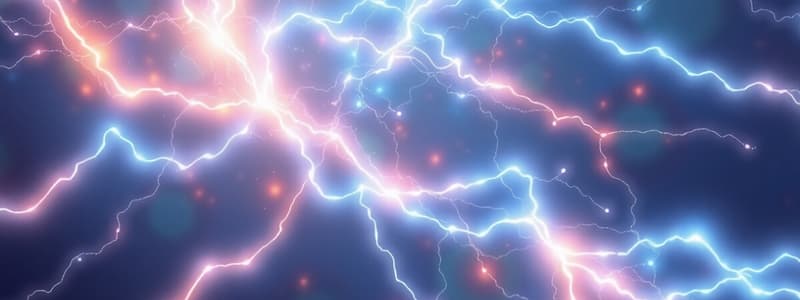Podcast
Questions and Answers
What is the main difference between direct current (DC) and alternating current (AC)?
What is the main difference between direct current (DC) and alternating current (AC)?
- DC has a constant flow of electrons, while AC has electrons that vibrate back and forth. (correct)
- AC is used in batteries, while DC is used in household circuits.
- DC frequency is measured in hertz, but AC is not.
- AC flows in one direction only, while DC can flow in both directions.
When AC electricity is generated in the U.S., what is the frequency at which the current cycles?
When AC electricity is generated in the U.S., what is the frequency at which the current cycles?
- 30 hertz
- 50 hertz
- 60 hertz (correct)
- 40 hertz
In a direct current (DC) circuit, what happens when the switch is turned on?
In a direct current (DC) circuit, what happens when the switch is turned on?
- Photons are released from the battery, illuminating the circuit.
- The circuit is completed, allowing electrons to flow from negative to positive. (correct)
- The light bulb produces a steady light that is not dependent on the switch.
- Electrons start to vibrate, causing flickering in the light bulb.
How does the flickering effect of a light bulb in an AC circuit appear to the human eye?
How does the flickering effect of a light bulb in an AC circuit appear to the human eye?
Which of the following statements about AC and DC circuits is accurate?
Which of the following statements about AC and DC circuits is accurate?
What is the primary characteristic of AC current?
What is the primary characteristic of AC current?
Which statement accurately describes DC power?
Which statement accurately describes DC power?
How does the voltage in AC power differ from that in DC power?
How does the voltage in AC power differ from that in DC power?
In what form do we commonly use DC power for portable devices?
In what form do we commonly use DC power for portable devices?
What is true about the flow of AC current compared to DC current?
What is true about the flow of AC current compared to DC current?
Flashcards
Electricity
Electricity
The flow of electrons through a wire, which can be either direct current (DC) or alternating current (AC).
Direct Current (DC)
Direct Current (DC)
A type of electric current where electrons flow in one direction, from negative to positive.
Alternating Current (AC)
Alternating Current (AC)
A type of electric current where electrons vibrate back and forth between positive and negative terminals.
Hertz (Hz)
Hertz (Hz)
Signup and view all the flashcards
Filament
Filament
Signup and view all the flashcards
Voltage
Voltage
Signup and view all the flashcards
Transformer
Transformer
Signup and view all the flashcards
Benefit of DC power
Benefit of DC power
Signup and view all the flashcards
Study Notes
Electron Flow in Electricity
- Electricity is the movement of electrons through wires, occurring in two forms: alternating current (AC) and direct current (DC).
Direct Current (DC)
- Electrons move in one direction, from negative (-) to positive (+).
- This flow is constant until the power source is depleted or switched off.
- In a simple circuit with a light bulb, electrons flow from the negative terminal through the switch, to the bulb.
- The bulb's filament heats up and glows using the electron's charge.
- Electrons then return to the positive terminal of the battery to be reused.
Alternating Current (AC)
- Electrons vibrate back and forth between negative and positive.
- This vibration isn't steady, but happens in synchronization with the generator's speed (frequency).
- The frequency is measured in Hertz (Hz).
- In the US, AC has a frequency of 60 Hz. This means electrons vibrate 60 times per second.
- This back-and-forth motion creates a flickering light that is too rapid for the human eye.
- AC is generated by a generator, where charges flow in both directions, opposite to DC's single direction
Comparing AC and DC
- AC current's flow is in a sine wave pattern.
- DC current's flow is constant in one direction.
Voltage
- Voltage is the force that moves electrons.
- Different electrical devices have different voltage requirements.
- AC voltage can be easily modified using transformers.
- DC voltage is easier for portable devices like batteries because higher voltage is not needed.
Studying That Suits You
Use AI to generate personalized quizzes and flashcards to suit your learning preferences.





